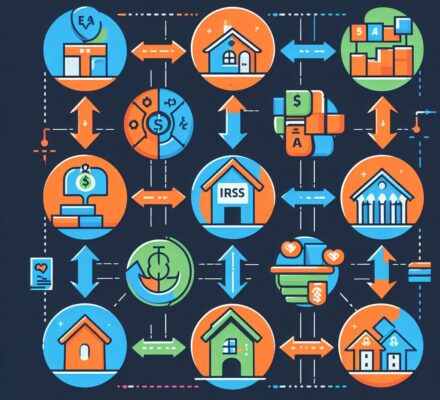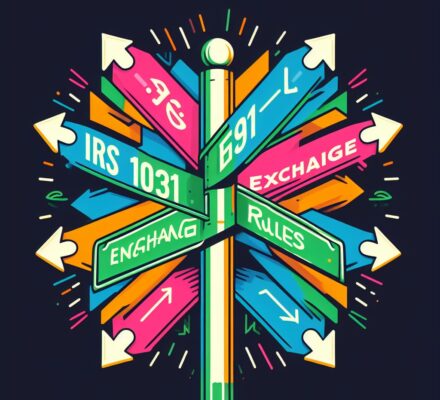Did you know that 1031 exchanges can be a powerful tool for rental property investors? If you’re considering a 1031 exchange, it’s important to understand the rules and regulations involved.
In this article, we will delve into the time limits, eligible properties, identification and acquisition rules, potential pitfalls, and tax implications of 1031 exchanges on rental properties.
By the end, you’ll have a clear understanding of how to navigate this complex process and maximize your investment opportunities.
Key Takeaways
- The identification period for potential replacement properties in a 1031 exchange on rental properties is 45 calendar days.
- Eligibility criteria for 1031 exchanges include the like-kind requirement and the holding period requirement, among others.
- The rules for identifying and acquiring replacement properties in a 1031 exchange are crucial and must be carefully followed.
- There are potential pitfalls and tax implications associated with 1031 exchanges on rental properties, and consultation with a qualified tax professional is important.
Time Limits for 1031 Exchanges
You must adhere to specific time limits when engaging in a 1031 exchange on rental properties. These time limits are crucial to understand and follow in order to successfully complete the exchange and defer your capital gains taxes.
The first time limit you need to be aware of is the identification period, which begins on the date you sell your relinquished property. During this period, which lasts 45 calendar days, you must identify potential replacement properties in writing to your qualified intermediary. Be sure to provide a clear and unambiguous description of the properties you intend to acquire.
The next time limit is the exchange period, which starts on the date you sell your relinquished property and ends 180 calendar days later. Within this timeframe, you must acquire the replacement property or properties that you have previously identified. It’s important to note that the exchange period includes the 45-day identification period.
Failure to meet these time limits will result in disqualification of your exchange and potential tax liability. Therefore, it’s crucial to carefully track and manage these deadlines to ensure a successful 1031 exchange.
Eligible Properties for 1031 Exchanges
To qualify for a 1031 exchange on rental properties, it’s important to understand the criteria for eligible properties. Here are the key factors to consider:
- Like-Kind Requirement: The property you’re selling and the property you plan to acquire must be of like kind. This means that both properties must be held for investment or business purposes. For example, you can exchange a residential rental property for a commercial rental property, but not for a personal residence.
- Holding Period Requirement: The IRS requires that you hold the property for at least 12 months before the exchange. This demonstrates your intent to hold the property for investment purposes.
- *Exception for Newly Constructed Properties:* If you’re exchanging a property that’s under construction, you must still meet the holding period requirement. However, the IRS allows you to count the construction period towards the holding period.
- *Exception for Personal Property:* Personal property, such as furniture or equipment, doesn’t have a minimum holding period requirement.
Understanding these eligibility criteria is crucial when considering a 1031 exchange on rental properties. Now, let’s move on to the next section to discuss the identification and acquisition rules.
Identification and Acquisition Rules
Continuing with the eligibility criteria, it’s important to understand the identification and acquisition rules for 1031 exchanges on rental properties.
When engaging in a 1031 exchange, you must identify your replacement property within 45 days of selling your relinquished property. This identification must be done in writing and submitted to a qualified intermediary. You’re allowed to identify up to three potential replacement properties, regardless of their value. However, if you wish to identify more than three properties, the total value of those properties can’t exceed 200% of the value of the relinquished property.
Furthermore, there are specific acquisition rules that must be followed. The purchase price of the replacement property must be equal to or greater than the net sales price of the relinquished property. Any cash or other property received during the exchange, known as ‘boot,’ may be subject to capital gains tax. To avoid this, you should aim to acquire a replacement property that’s of equal or greater value than the relinquished property.
It is important to note that these identification and acquisition rules are critical in order to qualify for the tax-deferred benefits of a 1031 exchange. Failing to comply with these rules may result in disqualification and potential tax liability.
Therefore, it’s recommended to consult with a qualified tax professional or real estate attorney to ensure compliance with all 1031 exchange rules and regulations.
Potential Pitfalls of 1031 Exchanges
When engaging in a 1031 exchange on rental properties, it’s important to be aware of potential pitfalls. These pitfalls can have serious consequences and can hinder the successful completion of the exchange.
Here are some potential pitfalls to watch out for:
- Inadequate identification of replacement properties:
- Failing to identify the replacement properties within the required 45-day identification period can result in the disqualification of the exchange.
- It’s crucial to carefully identify the replacement properties and ensure they meet the requirements of like-kind property.
- Failure to meet the strict timelines:
- 1031 exchanges have strict timelines that must be adhered to.
- Failing to meet the 180-day exchange period or the 45-day identification period can lead to the disqualification of the exchange and potential tax liabilities.
These potential pitfalls highlight the importance of careful planning and adherence to the rules and timelines of a 1031 exchange. By being aware of these pitfalls and taking the necessary precautions, you can increase the chances of a successful exchange without incurring unnecessary tax liabilities.
In the next section, we’ll discuss the tax implications of 1031 exchanges and how to navigate them effectively.
Tax Implications of 1031 Exchanges
Understanding the tax implications of 1031 exchanges on rental properties is essential for successful execution. When it comes to taxes, the main advantage of a 1031 exchange is the ability to defer capital gains taxes on the sale of an investment property. By reinvesting the proceeds into another like-kind property, you can postpone paying taxes on the gains until a future sale. This allows you to potentially grow your real estate portfolio without being burdened by immediate tax liabilities.
However, it’s important to note that a 1031 exchange doesn’t eliminate your tax obligations entirely. While the capital gains tax is deferred, it isn’t forgiven. When the replacement property is eventually sold, the deferred taxes will become due. It’s crucial to consult with a qualified tax professional to fully understand your tax obligations and to ensure compliance with the IRS rules and regulations.
Additionally, it’s worth mentioning that there may be other tax implications associated with a 1031 exchange. For example, there could be state-level taxes, such as state capital gains taxes, that need to be considered. Each state may have its own rules and regulations regarding 1031 exchanges, so it’s important to take these into account.
Frequently Asked Questions
Are There Any Restrictions on the Types of Properties That Can Be Exchanged in a 1031 Exchange?
There are restrictions on the types of properties that can be exchanged in a 1031 exchange. These restrictions include limitations on personal property, primary residences, and properties outside of the United States.
Can I Exchange a Rental Property for a Property That Is Not Currently Being Used for Rental Purposes?
Yes, you can exchange a rental property for a property that is not currently being used for rental purposes. The rules for 1031 exchanges allow for the exchange of different types of properties.
Can I Use a 1031 Exchange to Exchange Multiple Rental Properties for One Property?
Yes, you can use a 1031 exchange to exchange multiple rental properties for one property. This allows you to consolidate your investments and defer capital gains taxes. Consult a tax professional for guidance.
Are There Any Limitations on the Location of the Replacement Property in a 1031 Exchange?
When it comes to the location of your replacement property in a 1031 exchange, there are no specific limitations. As long as it meets the criteria of being used for investment purposes, you have flexibility in choosing where it’s located.
Can I Use a 1031 Exchange to Defer Taxes on the Sale of a Rental Property That Has Been Partially Used for Personal Purposes?
Yes, you can use a 1031 exchange to defer taxes on the sale of a rental property that has been partially used for personal purposes. However, there are specific rules and limitations to consider.




